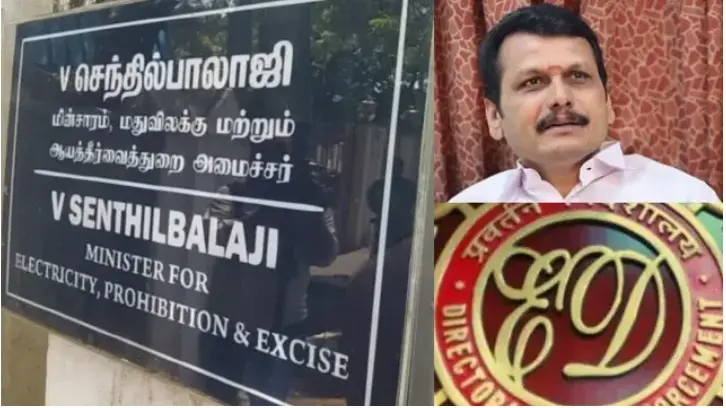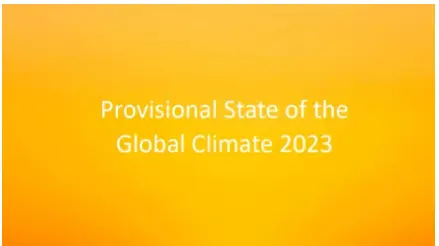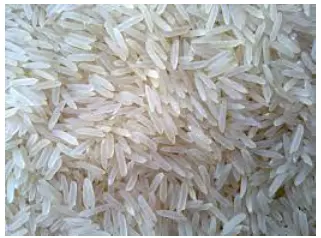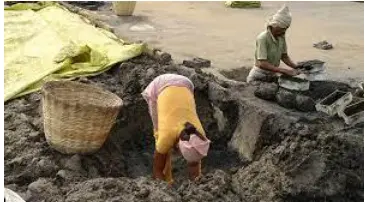Wednesday, 27th March 2024
Delhi Excise Policy Case
In News: In a recent development, a Magistrate Court in Delhi has ordered the Chief Minister of Delhi to be remanded to the custody of the Enforcement Directorate (ED) regarding his involvement in the Excise Policy Case.
Allegations
- The Delhi Excise Policy of 2021-22 faced severe scrutiny due to allegations of arbitrary decision-making, resulting in substantial financial losses estimated at over Rs 580 crore. These decisions were reportedly made unilaterally by the Deputy Chief Minister and Excise Minister of Delhi.
- Additionally, there are accusations of a conspiracy involving certain private companies in the alcohol business, with claims that the policy was designed to ensure a 12% profit margin for them. It's alleged that this arrangement involved kickbacks amounting to 6%.
- The Enforcement Directorate (ED) has also raised concerns about cartel formation and preferential treatment within the industry, purportedly benefiting leaders of the Aam Aadmi Party (AAP). Preferential treatment included discounts, fee extensions, penalty waivers, and relief due to pandemic disruptions.
- Moreover, there are allegations that the kickbacks received through this scheme were utilized to influence Assembly elections in Punjab and Goa in early 2022.
Can an Incumbent Chief Minister Govern from Jail?
- Constitutional Morality and Good Governance
- The issue of whether a Chief Minister can govern from jail raises questions about constitutional morality, good governance, and public trust, which are foundational principles in holding public office.
- Unlike the President and Governors, Chief Ministers do not enjoy immunity from civil and criminal proceedings. They are subject to the same legal framework as any other citizen.
- Although the law does not automatically disqualify a Chief Minister upon arrest, constitutional norms dictate that public officials, particularly those in high office, should adhere to standards of ethical conduct and governance.
- Legal Framework
- Under the legal framework, a Chief Minister can only be disqualified or removed from office upon conviction in a court of law. Mere arrest does not warrant removal.
- Provisions in the Representation of the People Act, 1951 outline disqualification criteria for certain offenses, but conviction is necessary for anyone holding the office to be ousted.
- The Chief Minister can lose office through loss of majority support in the assembly or a successful No-Confidence Motion against the government they lead.
- Basic Norms for Holding Public Office
- Upholding constitutional morality and good governance is essential for public officeholders. Citizens expect individuals in power to act with integrity and in the public interest.
- High standards of moral conduct are particularly expected from Chief Ministers, who are entrusted with significant responsibilities and are seen as the embodiment of public faith.
- Practical Difficulties of Functioning from Jail
- The practical challenges of governing from jail are substantial. Access to official documents, communication with government officials, and the ability to fulfill duties effectively may all be compromised.
- While it may be technically possible for a Chief Minister to continue in office while in custody, concerns about the legitimacy and effectiveness of their leadership would likely arise.
- Precedents and Case Law
- Precedents, such as the S. Ramachandran versus V. Senthil Balaji Case of 2023, underscore the practical difficulties of holding public office while facing serious allegations or legal proceedings.
- Questions have been raised about the propriety of individuals receiving a salary from the public exchequer while occupying a public office without performing associated duties.
- President’s Rule
- In situations where it becomes impractical for a Chief Minister to govern from jail, the Lieutenant Governor can invoke 'failure of constitutional machinery in the state' as a basis for imposing President's rule.
- President's rule places the national capital under the direct control of the Union government, circumventing the challenges of a Chief Minister governing from jail.
What is the ED?
- About
- The Enforcement Directorate (ED) operates as a multi-disciplinary organization under the Ministry of Finance, mandated to investigate offenses related to money laundering and violations of foreign exchange laws.
- Its headquarters in New Delhi oversee operations across regional offices in major cities like Mumbai, Chennai, Chandigarh, Kolkata, and Delhi.
- Structure
- The ED draws its officers from various backgrounds, including IRS, IPS, and IAS.
- Directors' tenure can be extended up to five years, facilitating continuity and expertise within the organization.
- Functions
- The Directorate is empowered to sponsor cases of preventive detention under the Conservation of Foreign Exchange and Prevention of Smuggling Activities Act, 1974 (COFEPOSA).
- It enforces laws such as the Foreign Exchange Management Act, 1999 (FEMA), and the Prevention of Money Laundering Act, 2002 (PMLA), conducting investigations, adjudicating penalties, and prosecuting offenders.
- The ED also plays a crucial role in implementing the Fugitive Economic Offenders Act, 2018 (FEOA), aimed at deterring economic offenders from evading the Indian legal system by fleeing the country.
|
UPSC Previous Year Questions Prelims (2013) Q. Which one of the following groups of items is included in India’s foreign-exchange reserves? (a) Foreign-currency assets, Special Drawing Rights (SDRs) and loans from foreign countries (b) Foreign-currency assets, gold holdings of the RBI and SDRs (c) Foreign-currency assets, loans from the World Bank and SDRs (d) Foreign-currency assets, gold holdings of the RBI and loans from the World Bank Ans: (b) Explanation:
Therefore, option (b) is the correct answer. Mains (2021) Q. Discuss how emerging technologies and globalisation contribute to money laundering. Elaborate measures to tackle the problem of money laundering both at national and international levels. |
Source: IE
Cinematograph (Certification) Rules, 2024
In News: In accordance with the Cinematograph (Amendment) Act, 2023, the Ministry of Information and Broadcasting has introduced the Cinematograph (Certification) Rules, 2024, replacing the obsolete rules from 1983.
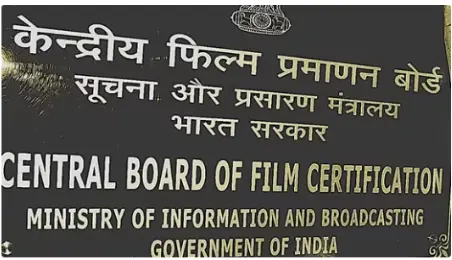
Cinematograph (Certification) Rules, 2024
Aim
The rules aim to modernize and adapt to evolving technologies and advancements in the film industry to ensure relevance and efficiency.
Key Aspects
- Alignment with Online Certification Processes: The rules have been extensively revised to align with online certification processes, enhancing transparency, efficiency, and ease of operation for the film sector.
- Reduction in Certification Time-Lines: Time-lines for film certification processing have been shortened by adopting fully digital processes, eliminating transactional delays.
- Accessibility Features for Films: Films are mandated to include accessibility features for certification, ensuring inclusivity for disabled individuals as per specified guidelines.
- Introduction of Age-Based Certification: The existing UA category is now subdivided into three age-based categories: UA 7+, UA 13+, and UA 16+, aiding parents or guardians in determining suitable content for children.
- Enhanced Gender Representation: The rules advocate for greater representation of women in the Central Board of Film Certification (CBFC) Board and Advisory Panels, promoting diversity in decision-making.
- System for Priority Screening of Films: Priority screening is introduced to expedite the certification process, especially for filmmakers with urgent commitments.
- Perpetual Validity of Certificates: Certificates issued by the CBFC are now valid indefinitely, removing the previous 10-year restriction.
- Recertification for Television Broadcast: Edited films intended for television broadcast must undergo recertification, allowing only films with Unrestricted Public Exhibition category certification to be aired.
Significance
- The overhaul of the rules recognizes advancements in film technology and evolving audience demographics.
- Complementing the amendments to the Cinematograph Act in 2023, these new rules simplify the certification process, making it contemporary and globally competitive.
Source: PIB
District Election Management Plan
In News: Election management has become complex, requiring meticulous planning. The District Election Management Plan (DEMP) is a crucial document utilizing statistics and analysis to ensure smooth elections.
About District Election Management Plan (DEMP)
Introduction
- The DEMP, as per the Election Commission of India (ECI), is a comprehensive plan prepared at least six months before the tentative poll day.
- It serves as a framework for electoral strategy and requires periodic revisions as the election approaches.
Collaborative Effort
- Execution of the DEMP involves collaboration among election officials, administrative authorities, law enforcement agencies, and other stakeholders.
- Regular interactions with political parties and media are planned to ensure understanding and adherence to electoral rules.
Features of DEMP
- District Profile: The plan begins with a district profile, including a political map outlining constituencies, demographic and infrastructure statistics, and administrative and socio-economic features.
- Accessibility of Polling Stations: Strategies are outlined to improve the availability and accessibility of polling stations, ensuring essential facilities like ramps, electricity, lighting, drinking water, toilets, and internet connectivity.
- Focus on Vulnerable Voters: Special attention is given to voters with disabilities (PwD) and senior citizens through help desks, control rooms, home voting options, etc.
- SVEEP Plan: The Systematic Voters’ Education and Electoral Participation (SVEEP) plan focuses on increasing electoral participation, analyzing voter turnout data, and tailoring activities accordingly.
- Personnel Planning: The plan includes strategies for planning, training, welfare, and deployment of election personnel, creating databases, categorizing personnel, and addressing gaps in personnel needs.
- Force Deployment: Detailed planning is done in coordination with the district police, including vulnerability mapping of polling stations and training district-level teams to enforce the Model Code of Conduct (MCC).
EVM Management
Plans for secure storage, availability, transportation, and maintenance of Electronic Voting Machines (EVMs) and Voter Verifiable Paper Audit Trails (VVPATs) are outlined, ensuring the integrity of the electoral process.
Significance
- The DEMP enhances the voting experience by organizing and making it accessible for everyone.
- Its approach of meticulous planning, collaboration, and transparency offers lessons for broader governance, emphasizing the importance of advanced planning and stakeholder collaboration to tackle challenges effectively.
Voter Verifiable Paper Audit Trail (VVPAT)
- VVPAT machines provide feedback to voters in ballotless voting systems, verifying that the vote cast goes to the correct candidate.
- It contains the candidate's name and symbol, offering instant feedback to voters to ensure the accuracy of their vote.
- Introduced as a pilot project in 2014, VVPATs were implemented in all Lok Sabha constituencies during the 2019 Indian general election.
Source: TH
Black Sea
In News: Following a series of successful Ukrainian attacks on Russia's Black Sea Fleet, Russia has designated Admiral Alexander Moiseev as the new acting head of its Navy due to substantial losses incurred.
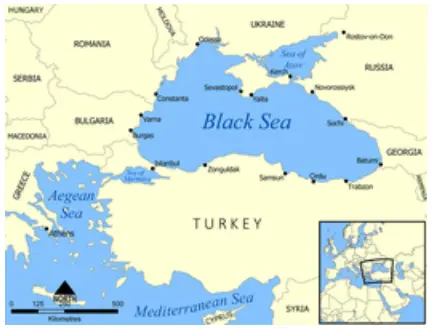
Key Facts About the Black Sea
- Geographical Importance
- The Black Sea, also known as the Euxine Sea, is a significant inland sea situated between Eastern Europe and Western Asia.
- Geographical Location
- Land Boundary: Borders Ukraine to the north and northwest, Russia and Georgia to the east, Turkey to the south, and Bulgaria and Romania to the west.
- Maritime Boundary: Connected to the Sea of Marmara through the Bosphorus Strait and to the Aegean Sea through the Dardanelles Strait. Also linked to the Sea of Azov by the Strait of Kerch.
- Transitional Zone
- The Turkish straits system forms a transitional zone between the Mediterranean and the Black Sea.
- Surrounding Mountains
- Surrounded by the Pontic Mountains in the south, the Caucasus Mountains in the east, and the Crimean Mountains in the north.
- Inflowing Rivers
- Supplied by major rivers such as the Danube, Dnieper, and Dniester, with the Danube being the second-longest river in Europe.
|
UPSC Previous Year Questions Prelims (2019) Q. Consider the following pairs: Black Sea Bordering Country
Which of the pairs given above are correctly matched? (a) 1, 2 and 4 only (b) 1, 3 and 4 only (c) 2 and 5 only (d) 1, 2, 3, 4 and 5 Ans: (b) Prelims (2014) Q. Turkey is located between (a) Black Sea and Caspian Sea (b) Black Sea and Mediterranean Sea (c) Gulf of Suez and Mediterranean Sea (d) Gulf of Aqaba and Dead Sea Ans: (b) |
Source: TH
International Day of Forests
In News: The National Zoological Park in New Delhi commemorated the International Day of Forests on March 21, 2024, focusing on the theme "Forests and innovation: new solutions for a better world."
Promoting Awareness and Importance of Forests: International Day of Forests and India's Forest Cover
- The event aimed to raise awareness among visitors regarding the significance of forests and their role in our lives.
- The International Day of Forests was proclaimed by the United Nations General Assembly in 2012 on 21st March to celebrate and promote awareness of all types of forests.
- Countries are encouraged to organize various activities related to forests and trees at local, national, and international levels, including tree planting campaigns.
- The United Nations Forum on Forests, the Food and Agriculture Organization (FAO), and other relevant organizations collaborate with governments to coordinate these efforts.
- According to the latest India State of Forest Report (ISFR) 2021, India's total forest and tree cover reached 80.9 million hectares, constituting 24.62% of the country's geographical area.
- Madhya Pradesh emerged with the largest forest cover, followed by Arunachal Pradesh, Chhattisgarh, Odisha, and Maharashtra.
- India's National Forest Policy of 1988 aims to have at least 33% of the total geographical area under forest cover to ensure ecological stability.
Source: PIB
Hyperloop Technology
In News: Recently, the spotlight has been on hyperloop technology due to its energy efficiency and sustainability.
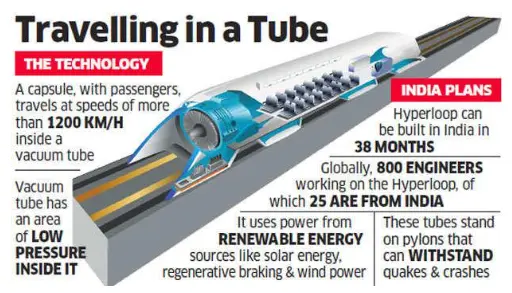
Overview of Hyperloop Technology and Challenges
- Developed by Elon Musk in 2013, Hyperloop aims to connect mobility hubs in large cities using pressurized tubes and capsules.
- The capsules, known as pods, would float at high speeds through contactless levitation and electromagnetic propulsion systems, while minimizing aerodynamic drag.
- Hyperloop is envisioned as a sustainable mode of transportation, potentially reducing reliance on driving or flying and easing congestion on traditional train lines.
- Despite its promise, Hyperloop technology faces challenges such as the high cost of infrastructure construction and maintenance, technical complexities in maintaining vacuum conditions within the tubes, and safety concerns associated with operating a high-speed transportation system.
Source: IE
Smart Meter National Programme
In News: Kerala's decision to pursue an alternative model for the implementation of smart electricity meters poses a challenge to the Union Government's Rs 3 lakh crore smart meters project.
About Smart Meter National Programme
- The Smart Meter National Programme (SMNP) is a government initiative aimed at promoting the widespread adoption of smart meters throughout India.
- Its primary objective is to enhance billing and collection efficiencies for distribution companies (DISCOMs) across the nation.
- The program is managed by Energy Efficiency Services Limited (EESL), a joint venture of four National Public Sector Enterprises.
- EESL aims to replace 25 crore conventional meters with smart meters as part of the initiative.
- Implementation of the program follows the Build-Own-Operate-Transfer (BOOT) model, where EESL covers all capital and operational expenses.
- States and utilities are not required to make upfront investments under this model.
- Cost recovery for the smart meters is facilitated through energy savings monetization, achieved via improved billing accuracy and reduced meter reading costs.
- Installation of smart meters adheres to guidelines outlined by the Central Electricity Authority (CEA).
- Smart meters offer benefits to both consumers and utilities.
- Consumers can monitor their electricity consumption, enabling them to make informed decisions and potentially save on bills.
- For utilities, smart meters enhance operational efficiency, aid in demand management, and reduce commercial losses.
- These benefits contribute to increased revenues and support power sector reforms.
Source: IE
National Disaster Response Fund
In News: The Karnataka government has approached the Supreme Court requesting a directive to the Centre to disburse financial aid from the National Disaster Response Fund (NDRF) to the state for managing drought conditions.
Overview of the National Disaster Response Fund (NDRF)
- Definition and Management
- Defined in Section 46 of the Disaster Management Act, 2005.
- Managed by the Central Government to cover emergency response, relief, and rehabilitation expenses during threatening disaster situations.
- Purpose and Composition
- Constituted to supplement State Disaster Response Funds (SDRF) in case of severe disasters.
- Placed in the "Public Account" of the Government of India (GOI) under "reserve funds not bearing interest," allowing the government to access funds without parliamentary approval.
- Eligibility and Coverage
- Covers natural calamities like cyclones, earthquakes, floods, and man-made disasters such as terrorist attacks or chemical incidents.
- Requires a memorandum from states detailing damage for availing funds, which are granted by the Centre after damage assessment.
- Utilization and Limitations
- Financial assistance is for immediate relief, not compensation for property damage.
- Not used for disaster preparedness or mitigation; other schemes cover these activities.
- Sources of Financing
- Financed through a cess on certain excise and customs duty items, approved annually.
- Additional fund requirements met through general budgetary resources.
- Decision Making and Accountability
- National Executive Committee (NEC) of the National Disaster Management Authority decides on fund allocation.
- NDRF accounts audited annually by the Comptroller and Auditor General (CAG).
Source: NDTV
Chalukyas of Kalyani
In News: An ancient Kannada inscription dating back 900 years, originating from the Kalyana Chalukya dynasty, has been discovered in a state of severe neglect at Gangapuram, a temple town in Mahaboobnagar district, Telangana.

Key Points About the Chalukyas of Kalyani
- Originating as a Kannadiga dynasty, they were named after their capital, Kalyani, located in present-day Bidar district, Karnataka.
- Founded by Tailapa II during the time when the Western Chalukyas were vassals of the Rashtrakuta Empire.
- The empire reached its pinnacle under Vikramaditya VI (1076-1126 CE), often referred to as the 'Chalukya Vikrama era'.
- Vikramaditya VI expanded the empire's territories, defeating adversaries like the Chola dynasty in battles such as Vengi in 1093 and 1118.
- The empire declined after Vikramaditya VI's reign, facing internal rebellions and external pressures, particularly from the Chola dynasty.
- Administration was largely hereditary, with powers passed down to male heirs or brothers.
- Feudatories like the Hoysala and Kakatiya managed various regions of the kingdom.
- The Chalukyas were tolerant of Buddhism and Jainism alongside Hinduism and contributed to the development of Kannada and Telugu literature.
- They minted punch-marked gold coins known as pagodas with Kannada inscriptions.
- Their architecture, known as the 'Gadag style', influenced Deccan architecture, bridging the styles of the Badami Chalukyas and Hoysalas.
- Notable temples include the Mallikarjuna temple in Bellary and the Siddeshvara temple in Haveri, showcasing both religious and secular themes.
Source: TH
Implementing Person-Centered Approaches for TB Control in India
In News: A recent article examines the ongoing public health issue of tuberculosis (TB) globally, with a focus on India.
Tuberculosis (TB) Burden in India: Challenges and Solutions
TB Burden in India: A Global Concern
- India accounts for 27% of global TB cases, despite TB being detectable and curable.
- TB is caused by the bacterium Mycobacterium tuberculosis, predominantly affecting the lungs but also other organs.
- TB remains the top infectious killer globally, causing 1.5 million deaths annually.
Challenges in Curing TB Burden in India
- Medicalization Over Humanitarianism
- TB has often been overly medicalized, neglecting its broader societal and humanitarian impacts.
- Disproportionate Impact on Marginalized Groups
- TB disproportionately affects marginalized populations, exacerbating social and economic disparities.
- Antibiotic Misuse and Drug Resistance
- Unregulated antibiotic use and non-compliance contribute to drug-resistant TB strains.
- Limited Access to Diagnostic Testing
- Cost and accessibility issues hinder widespread molecular testing for TB.
- TB-Diabetes Mellitus (DM) Dual Burden
- The coexistence of TB and DM poses additional challenges to treatment outcomes and healthcare systems.
Steps to Address the TB Crisis
- Prioritize Patient-Centric Approaches
- Focus on patient needs and community engagement within the healthcare system.
- Bridge Policy Intent with Ground Realities
- Implement targeted interventions to improve TB diagnosis and treatment accessibility.
- Strengthen Community-Based Care
- Empower frontline healthcare workers to provide comprehensive, holistic care.
- Adopt Multi-Sectoral Approaches
- Address socio-economic determinants of TB through collaborative efforts across sectors.
- Leverage Technology and Innovation
- Utilize AI and digital health solutions to enhance TB diagnosis, treatment, and surveillance.
- Implement an 8-Point Agenda for TB Control
- Prioritize early detection, precise treatment categorization, treatment adherence, and mortality reduction.
- Ensure Availability of Appropriate Medicines
- Address procurement challenges for drug-resistant TB medications and ensure treatment facilities.
- Consider Population Mobility and Migration
- Ensure portability of TB treatment and strengthen referral networks to address mobility issues.
Conclusion
- Eliminating TB in India requires a comprehensive, person-centered approach addressing social determinants of health and embracing innovation.
- Emphasizing streamlined implementation and proactive adoption of new technologies is crucial to overcoming barriers and creating a healthier future for all citizens.
Source: TH
Share the article
Edukemy’s Current Affairs Quiz is published with multiple choice questions for UPSC exams
MCQ
Get Latest Updates on Offers, Event dates, and free Mentorship sessions.

Get in touch with our Expert Academic Counsellors 👋
FAQs
UPSC Daily Current Affairs focuses on learning current events on a daily basis. An aspirant needs to study regular and updated information about current events, news, and relevant topics that are important for UPSC aspirants. It covers national and international affairs, government policies, socio-economic issues, science and technology advancements, and more.
UPSC Daily Current Affairs provides aspirants with a concise and comprehensive overview of the latest happenings and developments across various fields. It helps aspirants stay updated with current affairs and provides them with valuable insights and analysis, which are essential for answering questions in the UPSC examinations. It enhances their knowledge, analytical skills, and ability to connect current affairs with the UPSC syllabus.
UPSC Daily Current Affairs covers a wide range of topics, including politics, economics, science and technology, environment, social issues, governance, international relations, and more. It offers news summaries, in-depth analyses, editorials, opinion pieces, and relevant study materials. It also provides practice questions and quizzes to help aspirants test their understanding of current affairs.
Edukemy's UPSC Daily Current Affairs can be accessed through:
- UPSC Daily Current Affairs can be accessed through Current Affairs tab at the top of the Main Page of Edukemy.
- Edukemy Mobile app: The Daily Current Affairs can also be access through Edukemy Mobile App.
- Social media: Follow Edukemy’s official social media accounts or pages that provide UPSC Daily Current Affairs updates, including Facebook, Twitter, or Telegram channels.

